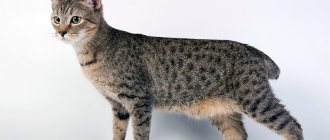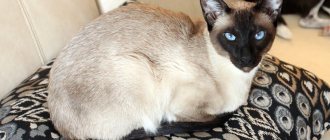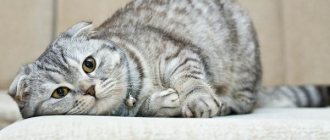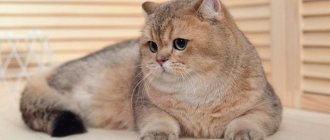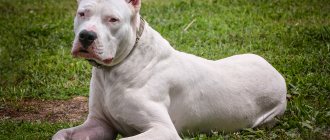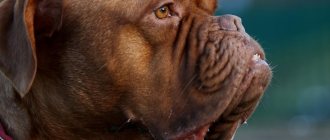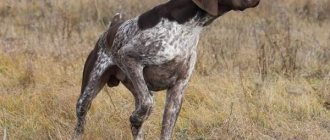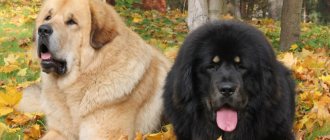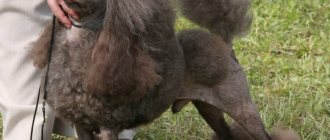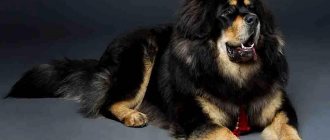Description of the Chausie breed
Popularity 20th place among 87 cat breeds
Lifespan:
13 years
Height:
up to 42 cm
Country of origin:
USA
Average price:
200-500 thousand rubles
Weight:
up to 16 kg
Latest articles Cat health
Ataxia in cats: what is it, how does it manifest and is treated 01/23/2022 163 0 0
Cat health
Leukemia, or viral leukemia in cats 01/23/2022 148 0 0
How much does it cost and where to buy a Chausie kitten?
Do you want to have your own wild animal as a pet? Get ready to shell out some cash, because the average price for a kitten is 300,000 rubles.
Chausie kittens are sold in nurseries. You can try to search through breeders, but in Russia there are very few people breeding this breed. Animals from nurseries can even be imported from other countries. The largest number of Hausie cats are found in the United States. You can search for breeders through forums dedicated to this breed in Moscow and St. Petersburg.
The cost of a kitten depends on its generation. The price of chausie f1 is about 500,000 rubles and even more. F5 Houseies cost approximately 100,000 rubles - this is the minimum cost of a kitten of this breed. For some kittens you will even have to pay a million rubles.
Advantages and disadvantages
- Pros:
- unusual appearance;
- friendliness and affection for the owner;
- getting along with children and pets;
- playfulness, energy;
- absence of genetic diseases.
- Minuses:
- high cost of kittens;
- hyperactivity and excessive curiosity;
- picky eating habits;
- impossibility of further breeding of purebred cats;
- the need for space in the home.
Key facts
The Chausie, or Houseie, breed was recognized five years after its appearance. She quickly gained numerous fans around the world, but even today there are few individuals. Shawsie cats are found in America, less often in European countries. In the former CIS countries there are very few Houses, which is why the cost of kittens is very high.
Description of the Chausie breed combines elegance, grace, mystery, beauty, cheerfulness, a kind and accommodating disposition, and a strong attachment to the owner and his family. The pet always tries to be visible and take part in everything that happens around.
Chausie owners claim that the cat’s character contains habits typical of dogs: it can be taught to walk on a leash and fetch small toys. The cat can even learn simple tricks from the training course.
Characteristics of the Chausie breed include the following factors:
- Country of origin: North America, late 60s – early 70s. last century.
- Registration - 1996 by the International Cat Association.
- Character traits - activity, energy, devotion to owners, getting along with children and other pets.
- With proper care and proper nutrition, the life expectancy of a Chausie cat is about 13 years.
- Care - to keep a Chausie you need 3 things: financial capabilities, enough free space in the home, the ability to devote a lot of attention and time to the cat.
Chausie does not tolerate loneliness well, showing excessive anxiety. She should not be left alone for long periods of time. An active cat is happy to participate in outdoor games; it can be placed in a house with a dog and decorative rodents.
History of the origin of chausie
The Chausie is a cat breed that retains the spirit of both ancestors. Unlike artificial breeds obtained by gene mutation, this pet is all naturalness.
The name “chausie” was given to the mustachioed cat from the name of the swamp cat (in Latin, Felis chaus). Almost a meter tall predator weighing about 22 kg lived in Africa, South Asia and the Caucasus. People have long tried to tame the domestic cat and, to some extent, they succeeded.
Chausie cats are the result of crossing a domestic cat and a swamp cat. The Abyssinian was usually used as the first, so at first glance the Shawsie can be mistaken for Felis catus (domestic cat).
The exact date of the appearance of hybrids is unknown, but there is an opinion that the first “experiments” in breeding the breed were carried out by Americans in the early 70s of the last century. But they were never crowned with victory, since the gorgeous cats degenerated in subsequent generations.
To consolidate the phenotype, short-haired “yard” cats were involved in Chausie breeding. But even today, the wild characteristics of the swamp ancestor can be preserved in descendants only up to the fifth generation, which explains the exclusivity and high price of kittens.
Unlike other cat breeds, Chausie cannot be accurately characterized without reference to generation, which is designated by the letter “F” (from Italian “Figli” translates as “children”), the number is displayed in numbers 1, 2 ... 5.
Thus, the F1 generation Housie was obtained by crossing an Abyssinian cat and a wild swamp cat. F2 is a hybrid of the next generation, where the grandfather is a jungle cat (the share of wild blood in the animal is no more than 25%). F3 – no more than 13% of the original genes remain from the swamp cat, F4 – no more than 7%, F5 – about 4%.
In the 5th generation, the external resemblance to a swamp cat practically disappears, and the descendant has characteristics of an Abyssinian, or less often, an ordinary yard cat. It is noteworthy that in the F1 litter, when a jungle cat is mated to a mongrel cat, Shawsie kittens with a large number of infertile males are born.
When F1 housezi are crossed with each other, the offspring often turn out sick or nonviable. In short, at this point in time there are many difficulties with breeding the breed that breeders still have to overcome.
Kinds
The Chausie breed is divided into several hybrid varieties, which are marked with the letter F and numbers from 1 to 5. The number after this letter shows the percentage of the blood of the dad - a jungle cat in the hybrid. The higher the numbers, the less “reed” blood.
The hybrid Chausie F1 is the most valuable and most expensive descendant, the first branch from the combination of House and a noble cat (by the way, in addition to the Abyssinian breed, the participation of a short-haired European breed is acceptable in the mating). About 50% wild blood, almost a copy of dad in appearance, and his temperament is also his, he is active, can occasionally show disobedience and even aggression. The size is large. It is also marked with the letter A.
The F2 hybrid is obtained from the combination of F1 with any descendant of the Chausie, it must contain at least 25% of the blood of a wild cat. This breed is the most popular, it has a large weight (up to 10 kg) and a democratic character. Marked as group A or B.
An F3 hybrid is the result of combining any type of Chausie with an F2 hybrid. “Reed” blood should be about 12.5%. The size is almost like that of a domestic cat, its character is soft, its color and appearance are similar to its wild ancestor.
Hybrids F4 and 5 contain a percentage of wild animal blood of 6.25% and 3.12%, respectively. These creatures are absolutely domestic, normal size, standard build. They are marked with the letter C or SBT, that is, descendants of the fourth and further generations after crossing with House. The resulting crossbreeds, depending on external data, can be used for mating with F1 and F2, or removed from breeding. The Chausie cat is considered a young hybrid breed; it constantly needs a “rush of wild blood.”
A little about the “parents” of the F1 chausie:
The jungle cat is a predatory wild feline animal, about 60-90 cm in length, weighing from 8 to 12 kg. The body is relatively short, the legs are high, the tail is short (21-30 cm), and there are small tufts on the ears. It lives near the banks of rivers, seas and lakes, in reed thickets or thorny bushes.
Tries to avoid open spaces. In our country it is found on the plains of Dagestan, on the coast of the Caspian Sea, and reaches the Volga. In the direction of the Terek and Kuma rivers it reaches Stavropol and North Ossetia. Also lives in Transcaucasia and Central Asia. Listed in the Red Book of the Russian Federation.
The Abyssinian cat is a noble breed that received official registration at the end of the 19th century in the United Kingdom. Cat breeds from Southeast Asia and Africa were taken for breeding. One of the first officially registered breeds. Slender, light, medium in size, weighs from 3 to 6 kg.
Satin silky coat, interesting color. Recognizable not only by its figure and color, but also by the white border of light hairs around the eyes, which gives expressiveness to the look and visually “opens” the eyes. The cat is a legend from African fairy tales, distinguished by intelligence and observation. The character is lively and sociable.
What does a chausie look like?
Chausies are quite large animals, second in size only to the Maine Coon and Savannah. At the withers, pets reach 42 centimeters. Males are slightly larger than female cats, this difference is due to sexual dimorphism. A purebred cat resembles its ancestor and weighs at least 16 kilograms. But the further away the generation of the wild ancestor, the smaller the descendants.
Muzzle
As you can see in the photo, the Chausie's head is small, slightly elongated, with angular cheekbones and a pronounced chin. The main difference between the breed is the presence of a mark above the eyes - the letter “M” and between the ears - “W”.
The ears are quite large and set high on the head. There are tassels at the ends, but if they are not there, then this is not considered a defect. The slanted eyes are golden or greenish in color. The cat has a quiet voice, he purrs gently and with pleasure.
Body type
The Shawsie's appearance has the confidence and strength of a predator. The body is muscular, the sternum is well developed, the paws are athletic, quite large and long, the tail is equal in length to three-quarters of the cat’s body.
The skeleton is developed, the shoulder blades are located high and well defined - the pet’s movements are similar to the running of a cheetah. Medium-length forelimbs and long, proportional hind legs create a strong push. The cat's posture is semi-crouched; there is a loose fold on the stomach, allowing the animal to move with wide strides.
Coat and color
Thick, short, fairly elastic coat repels dirt and water well. It is silky, the guard hairs are ticked.
The varieties of Chausie cats in terms of color tones are few in number. In nature, you can find only 3 colors of Chausie: completely black, ticked silver and tabby (striped brindle). The most valuable is a cat with a silver ticked tabby and a black ticked tabby color, which resemble the coloring of a wild ancestor.
Appearance
Chausie F1
The appearance of the representatives of the breed is worthy of praise from cat lovers from all over the world. Chausie - moderately muscular animals with a proportionally built body - are very similar to their distant ancestors. Despite inbreeding with the Abyssinians, the cats managed to maintain impressive dimensions: a weight of 14-15 kg and a height at the withers of up to 40 cm.
The Chausie is classified as a medium-sized short-haired breed. They are distinguished by pronounced sexual dimorphism: males are 15-20% larger than females.
Head and skull
The cat's head is distinguished by the shape of a wedge or, as it is also called, an elongated triangle. Moderately elongated, but looks small in comparison with the body of the Chausie. It has graceful outlines, no angularity. The forehead is flat and wide, the occipital protuberance is slightly pronounced. The skull is rounded.
Muzzle
The neat and small muzzle of the animal is composed of smooth lines. Stop – the transition from the nose to the forehead is quite sharp. The bend of the high cheekbones in the direction of the cheekbones is also noticeable. The nose and chin of the Chausie form a straight line. It is noteworthy that the width of the bridge of the nose depends on the gender of the animal: in cats it is narrower. The lobe is convex.
Ears
Chausie F2
Large ears with a wide base are set high, almost on the top of the Chausie's head. The distance between the “triangles” is significant. The reverse side of the ears is decorated with false “eyes” - spots that the cat inherited from its distant ancestors from Egypt. The tips of the ears are pointed and crowned with small tassels. The presence of the latter is welcome, but the absence is not regarded as a breed defect.
Eyes
The almond-shaped eyes of the Chausie are set quite close, slightly slanted. Amber or deep yellow pigmentation is preferred. Variation in the shade of the iris within the yellow-green palette is acceptable.
Jaws and teeth
A cat's developed jaws form a scissor or level bite.
Neck
Muzzle of a Chausie cat
The thick and short neck of a Chausie does not look awkward and allows the animal to maintain harmonious body proportions.
Frame
Chausie kitten
The cat's tightly built and heavy body has superbly developed muscles. As Chausie owners are used to joke about their pets: “It’s like an Abyssinian on anabolic steroids!” The animal's chest is quite deep and wide, which contrasts with the cat's narrow shoulders and pelvis. The back is straight, the underline is moderately tucked.
Tail
The Chausie's straight and flexible tail is notable for its lack of kinks. Wide at the base and quite mobile, making up ¾ of the body length.
Limbs
The animal's legs provide powerful propulsion, so don't be surprised if your pet can easily jump onto the highest shelf in the closet. The muscles are well developed. The Chausie's paws are large, but despite this, they look compact. Fingers are not tightly gathered.
Coat
The short fur fits tightly to the body of the animal. Elastic hairs have a healthy shine. The undercoat is developed. The guard hair is ticked (unevenly colored) in at least two places.
Color
The Chausie breed standard provides for three main colors:
Chausie kitten F2 black and silver color
- black. The cat's fur is evenly colored, there are no marks;
- black ticked tabby. The hairs are colored with two or three stripes. The undercoat has a golden-red hue. The points are located on the tail and inside of the Chausie's paws; on the body they are unacceptable. The chin and eye rims are highlighted;
- black and silver ticked tabby. The guard hair has two or three ticking stripes of silver and black colors. The tips are always painted in a dark shade. Pronounced tabby points are undesirable.
Possible defects
A Chausie breed defect is any deviation from the standard. Among the main ones are:
- small, close-set ears;
- atypical pigmentation of the iris;
- poorly filled chest;
- clearly rounded head shape;
- excessively elongated neck;
- weak stop;
- hunchback.
Animals are disqualified for the following reasons:
- short tail (less than ¾ body length);
- white points on the body;
- amputated claws;
- congenital deafness;
- undescended testicles.
Chausie character
The main feature of the house is that they incredibly combine a sweet, kind pet and a wild animal. By nature, Chausies are self-confident, completely independent cats with absolute friendliness and self-esteem. They are strongly attached to the owner and all other household members.
The presence of smaller animals is allowed in the apartment - Chausie gets along well with them. The dog will also not become a hindrance in getting such a pet: the cat will begin friendship with it on a full-fledged basis.
Shawzies are incredibly smart and easy to train. Cats enjoy being in the company of people or watching them from above. Large dimensions and fairly heavy weight do not allow the animal to sit comfortably on a person’s lap, but it will be enough for them to rub their head against the owner’s legs. Animals also receive pleasure from light scratching behind the ears, stroking the back with a hand and other types of attention.
Cats have retained this quality of making provisions for a rainy day. Unnoticed, they will hide part of the portion in a secluded place, as their ancestors did in the wild. Be prepared for the possibility that an unpleasant odor may appear in your home from the most unexpected place.
Cats love to sit on a high place and watch what is happening. This feature is inherent in many mustachioed cats, but when a 16-kilogram cat jumps onto a shelf, a piece of furniture simply may not withstand the load. Therefore, before getting such a pet, securely fasten all structures and remove fragile interior items.
Reproduction and lifespan
Despite good heredity, Chausie males often become infertile after the first generation. Cats are fine with this, so the breeding of the following hybrids relies on them. To get kittens with the appearance of a real chausie, you need to organize a mating with a jungle cat. This is not easy to do, therefore, starting from the F2 generation, animals are deprived of their uniqueness.
If pregnancy occurs, then its duration is 64-70 days.
Chausie cats live for about 15 years
Raising a Chausie
Raising a Chausie should be done from the first days of the kitten's appearance in the home. Pets have developed intelligence, they quickly learn to understand the owner and carry out all his commands. The owner must maintain a balance and give the baby enough love, care and attention. without forgetting about the animal’s personal space. To raise a kind and obedient animal, you need to respect its desires and free will.
Initially, train the kitten to use the litter box. Patience and perseverance will be required, since the appearance of puddles in your home is inevitable. The main success factors are the correct selection of a place for the cat litter, the type of litter and attention to behavior in moments of anxiety. You can also train your pet to use the toilet - for this, a set of special devices is sold in the pet store.
No less attention should be paid to introducing the baby to a scratching post - with its sharp claws, an animal can damage pieces of furniture, clothing, wallpaper, and more. By accustoming your pet to a scratching post from the first days of living in the house, you will protect your things from damage, and the kitten from developing a bad habit.
Every attempt at mischief must be immediately stopped by shouting loudly, clapping your hands, or spraying water. In exceptional cases, you can use light physical punishment - a weak slap on the back with a wooden stick or newspaper will make it clear to the kitten that this cannot be done.
Particular importance in raising chausie should be given to causing harm to the legs, arms, and other parts of the human body. From the first days of living in the apartment, the cat is made to understand that these are not toys, and under no circumstances should they be scratched or bitten.
Shawzi should also be taught hygiene. Periodic brushing, washing, and examining eyes, teeth, and ears should become routine procedures for your pet. Equally important is the socialization of the baby - they put a leash and harness on him and first lead him around a confined space, after which he is introduced to the surrounding nature and other animals.
Chausie health
The Hausie breeder is lucky - the animals are endowed with excellent health, but have sensitive digestion and are prone to obesity. From their ancestors they received resistance to infectious diseases, and timely vaccination can significantly increase immunity.
The first vaccination against panleukopenia, rhinotracheitis and calicivirus is given to a cat at the age of 9-10 weeks, and it is repeated after 30 days. Until the age of one, a rabies vaccine is also administered. Vaccination should be preceded by a course of worm prevention - 2 weeks before vaccination, the baby is given an anthelmintic drug.
Possible diseases
If your pet's diet includes raw meat, deworming should be done regularly. Frequent walks in nature require treatment of the coat with flea and tick repellents.
With proper care and nutrition, the health of the Chausie throughout its life is not of particular concern. Annual visits to your veterinarian are recommended to perform a general examination and detect problems at an early stage of development.
Reproductive health
Breeding Shawsies is not an easy task. Even in an F1 pair, the valuable genetic qualities of the parents will be reduced by half in the next litter. This will be noticeable in the appearance of the descendants.
In general, Chausie cats do not produce equally purebred offspring: the babies often turn out to be completely ordinary. A successful breeding result is rather an exception to the rule. In addition, cats from both F1 parents are almost always sterile. This is what makes the breed so expensive and rare throughout the world.
If the cat becomes pregnant, then everything proceeds according to the usual scenario. The duration of pregnancy for a Chausie is 60 days. Kittens that are born before this period are premature and often die.
Shawsies usually give birth to 4-6 kittens. You can give birth yourself, having prepared the place, necessary supplies, instruments and medications - or invite a doctor.
If breeding cats is not planned, it is recommended to perform sterilization or castration. By surgical intervention, the testes of cats are removed, and the uterus and ovaries of cats are removed. After this, the animal loses the ability to reproduce offspring and becomes calmer and more affectionate.
How to choose a kitten
It is best to purchase an animal at least 3 months old. The appearance of the baby completely coincides with the adult, so they pay attention to compliance with the established standard. The kitten should not be lethargic. A healthy baby's ears and eyes are clean and his fur is free of bald spots. There should be no wounds on the skin.
At the time of purchase, the breeder is required to present the following documents:
- contract of sale;
- pedigree of the cat;
- veterinary passport showing vaccinations.
Note! When buying an animal, you should study the documents of the place where they are bred. This must be a specialized nursery with permission to breed this breed. Otherwise, the person involved in illegal sales may be arrested.
It is difficult to find purebred Chausies in Russia, so you should go to the USA or France to get kittens. Otherwise, you may run into scammers.
Features of feeding and diet
The nutrition of the chausie should be given special attention. Pets definitely won’t eat food waste; the ideal solution is to buy premium and super-premium dry food.
If you plan to feed the Chausie with natural food, then the daily diet should include:
- raw, boiled pork, beef, chicken meat;
- sea and river fish without bones;
- chicken eggs;
- curdled milk, low-fat cottage cheese, sour cream, fermented baked milk, kefir;
- cereal porridge;
- fruits, boiled and raw vegetables, greens;
- vitamins from a veterinary pharmacy.
The diet must be composed correctly, as animals are prone to overeating.
Clean water should be freely available and in the required quantity. Boiled liquid is not suitable - it can lead to the formation of stones in the bladder and kidneys. It is wiser to give your cat bottled water.
A kitten should be fed 3-4 times a day, teenagers - three times a day. In the first case, they give 220 grams of feed per day, in the second - 250 grams. Adult animals are fed 2 times a day, the total amount of food should not exceed 440 grams.
Care and maintenance
When giving preference to the Chausie breed, remember that these are active, energetic, curious pets that require constant attention and free space for active games. They definitely won’t sit in one place.
The ideal place for keeping is a spacious courtyard of a private house, where cats can freely walk and climb bushes and trees. If this is not possible, you should think about arranging your home.
The apartment in which the chausie settles should be spacious. The breed is impressive in size and loves to jump and run. Free space for such movements must be required. In addition, the animal must be regularly walked outdoors using a leash and harness.
Cats are similar in character to dogs - they can be taught to fetch small objects and follow voice commands. They are overly sociable and need increased attention from family members. At the same time, the pets are incredibly dexterous and jumping. All breakable things in the home should be hidden, and pieces of furniture should be well secured.
For games, you can equip your apartment with ladders and special houses where you can climb, hide and watch from above what is happening around you. This is how the ancestor of the Howzi, the swamp cat, behaved. It is imperative to have a scratching post in the house, otherwise sofas and carpets will be scratched by the strong and sharp claws of the animal.
Chausies enjoy playing with small children without injuring them or getting offended by pranks. If there are no children in the family, the owner needs to be prepared for the fact that he will have to entertain the pet himself - there should be interesting toys in the house: balls, rustling toys, fishing rods, mice. Having other pets who will definitely make friends with the sociable and cheerful cat will also help in this matter.
In general, caring for and maintaining the Chausie is not particularly difficult. Animals do not have a specific smell, their fur is thick and hard, practically does not get dirty, and it is enough to comb it 1-2 times a week. The massage brush perfectly removes dead hair and improves blood flow.
Cats also like bathing – this hygiene procedure can be performed with pleasure. But you shouldn’t overuse it either, as you can wash out all the natural fat from the wool. Regular examination of the animal’s ears and eyes and removal of wax and foreign deposits with a damp cloth are also useful.
The oral cavity of the chausie also requires no less attention: heavy plaque and stones on the teeth can lead to the development of caries and swelling of the gums. For prevention, the cat is allowed to gnaw on cartilage and bone tendons - they naturally clean the dental tissue. Regular brushing of teeth with a special paste is also recommended.
About breeding
Breeding the Hausi is a long and labor-intensive process. Even experienced breeders believe that this is exorbitant work. Breeders are of the same opinion - that’s why they are not particularly keen on breeding and keeping these cats, despite the opportunity to get rich.
It is worth considering that all chausie f1 males are sterile. At the same time, Chausie f1 are the most expensive representatives of the breed. Accordingly, their breeding is much more profitable (when compared with chausie f2, f3, and so on).
Kittens must be born in a specially prepared place. Mandatory conditions are dryness and warmth. In the future, babies should feed on mother's milk for as long as possible.
One of the parents must be a jungle cat. Chausie f1 can be crossed with an Abyssinian or domestic smooth-haired cat. In this case, the resulting kittens will belong to the f2 generation.
Any impurities in the blood are unacceptable. Non-purebred Hausie cats can be distinguished by their appearance. The only combination that leads to the appearance of chausie f1 is the marsh lynx and the Abyssinian cat.
Tips for choosing a kitten
Before purchasing a Chausie kitten, you need to immediately understand that getting from him purebred offspring with the characteristics of the parents is out of the question, since the value of the next litter is lost by half. As you move away from F1, the unique qualities of wild cats, their size and weight, decrease.
When getting an elite breed, you need to understand that this is a “disposable” elite pet, and it will not be possible to fully compensate for the costs by selling kittens. In addition, today you cannot buy Housei in the Russian Federation and CIS countries; there are official nurseries only in America and France.
If you are offered to buy a “purebred” Chausie cat on an online ad site, rest assured that you are dealing with scammers. A purebred kitten can only be purchased from an official breeder. To do this, you will have to send an application and wait 3-4 months for the next brood.
It is better to entrust the purchase of a kitten to a specialist with a good reputation. He will contact a time-tested foreign breeder and, with all the accompanying documents, will deliver the baby straight home to the new owner.
Castration and sterilization
If you do not set yourself the goal of breeding the breed, then it is necessary to undergo a sterilization operation. In many countries, this operation is a requirement for keeping non-breeding pets. This has been proven time and again to be the most humane way to treat your pets. Moreover, this operation must also be carried out with sterile animals.
The best time for surgery: before puberty. This usually corresponds to nine months of age.
